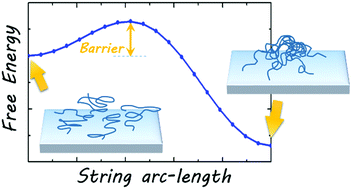Minimum free-energy paths for the self-organization of polymer brushes†
Abstract
A methodology to calculate minimum free-energy paths based on the combination of a molecular theory and the improved string method is introduced and applied to study the self-organization of polymer brushes under poor solvent conditions. Polymer brushes in a poor solvent cannot undergo macroscopic phase separation due to the physical constraint imposed by the grafting points; therefore, they microphase separate forming aggregates. Under some conditions, the theory predicts that the homogeneous brush and the aggregates can exist as two different minima of the free energy. The theoretical methodology introduced in this work allows us to predict the minimum free-energy path connecting these two minima as well as the morphology of the system along the path. It is shown that the transition between the homogeneous brush and the aggregates may involve a free-energy barrier or be barrierless depending on the relative stability of the two morphologies and the chain length and grafting density of the polymer. In the case where a free-energy barrier exists, one of the morphologies is a metastable structure and, therefore, the properties of the brush as the quality of the solvent is cycled are expected to display hysteresis. The theory is also applied to study the adhesion/deadhesion transition between two opposing surfaces modified by identical polymer brushes and it is shown that this process may also require surpassing a free-energy barrier.



 Please wait while we load your content...
Please wait while we load your content...